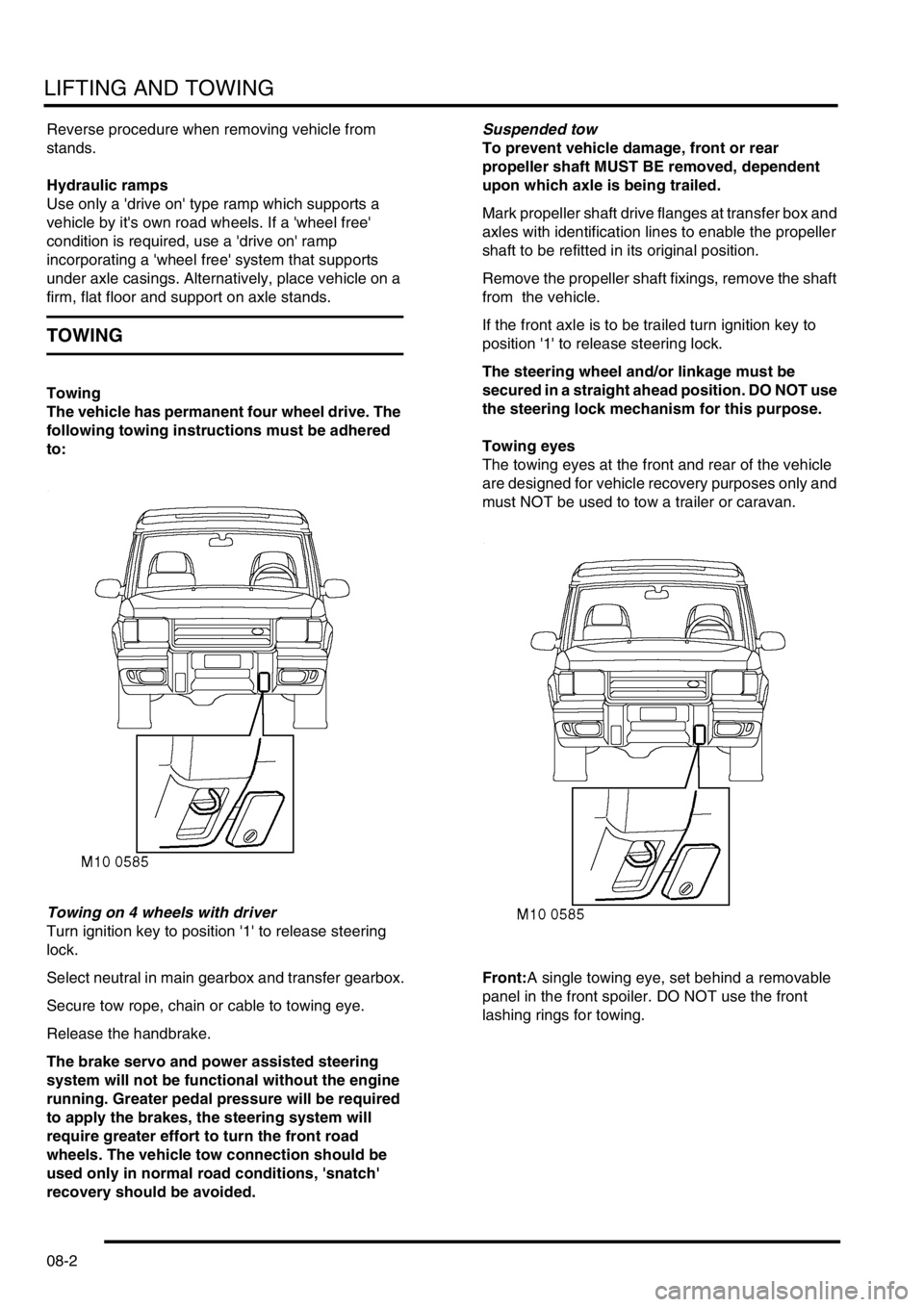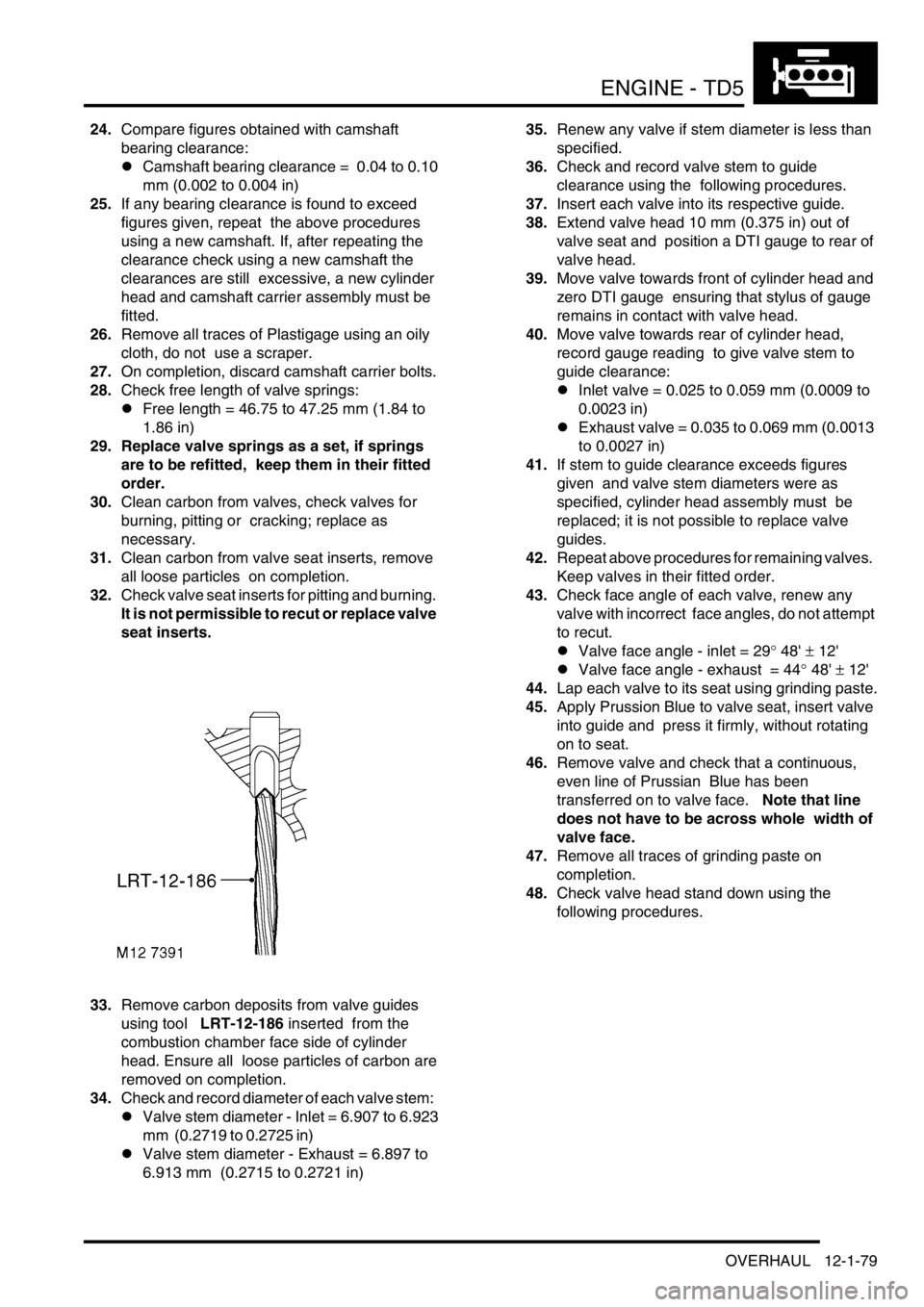2002 LAND ROVER DISCOVERY tow
[x] Cancel search: towPage 102 of 1672

LIFTING AND TOWING
08-1
LIFTING AND TOWING
LIFTING
The following instructions must be carried out before
raising the vehicle off the ground.
lUse a solid level ground surface.
lApply hand brake.
lSelect 'P' (Automatic gearbox) or 1st gear
(Manual gearbox) in main gearbox.
lSelect Low range in transfer gearbox.
To avoid damage occurring to the under body
components of the vehicle the following jacking
procedures must be adhered to.
DO NOT POSITION JACKS OR AXLE STANDS
UNDER THE FOLLOWING COMPONENTS:
lBody structure
lBumpers
lFuel lines
lBrake lines
lFront radius arms
lPanhard rod
lSteering linkage
lRear trailing arms
lFuel tank
lEngine sump
lGearbox bell housing
Vehicle jack
The jack provided with the vehicle is only intended for
use in an emergency, for changing a tyre. DO NOT
use the jack for any other purpose. Refer to Owner's
Handbook for vehicle jack location points and
procedure. Never work under a vehicle supported
solely by the vehicle jack.
Hydraulic jack
A hydraulic jack with a minimum 1500 kg, 3,300 lbs
load capacity must be used. Do not commence
work on the underside of the vehicle until
suitable axle stands have been positioned under
the axle.
WARNING: Always chock the wheels when
jacking. The hand brake acts on the
transmission, not the rear wheels, and may be
ineffective when the wheels are off the ground.Raising and supporting the vehicle
Position cup of hydraulic arm under differential
casing (1).The differential casing is not central to
the axle. Care should be taken when raising the
front road wheels off the ground as the rear axle
has less sway stiffness.
Raise vehicle to enable an axle stand to be installed
under left hand axle tube (2).
Position an axle stand under right hand axle tube (4).
Carefully lower jack until vehicle sits securely on both
axle stands, remove jack.
Alternatively, the axle stands can be positioned
under the chassis longitudinals at the front and/or
rear of the vehicle.
Before commencing work on underside of vehicle re-
check security of vehicle on stands.
WARNING: Always chock the wheels when
jacking. The hand brake acts on the the
transmission, not the rear wheels, and may be
ineffective when the wheels are off the ground.
Page 103 of 1672

LIFTING AND TOWING
08-2
Reverse procedure when removing vehicle from
stands.
Hydraulic ramps
Use only a 'drive on' type ramp which supports a
vehicle by it's own road wheels. If a 'wheel free'
condition is required, use a 'drive on' ramp
incorporating a 'wheel free' system that supports
under axle casings. Alternatively, place vehicle on a
firm, flat floor and support on axle stands.
TOWING
Towing
The vehicle has permanent four wheel drive. The
following towing instructions must be adhered
to:
Towing on 4 wheels with driver
Turn ignition key to position '1' to release steering
lock.
Select neutral in main gearbox and transfer gearbox.
Secure tow rope, chain or cable to towing eye.
Release the handbrake.
The brake servo and power assisted steering
system will not be functional without the engine
running. Greater pedal pressure will be required
to apply the brakes, the steering system will
require greater effort to turn the front road
wheels. The vehicle tow connection should be
used only in normal road conditions, 'snatch'
recovery should be avoided.Suspended tow
To prevent vehicle damage, front or rear
propeller shaft MUST BE removed, dependent
upon which axle is being trailed.
Mark propeller shaft drive flanges at transfer box and
axles with identification lines to enable the propeller
shaft to be refitted in its original position.
Remove the propeller shaft fixings, remove the shaft
from the vehicle.
If the front axle is to be trailed turn ignition key to
position '1' to release steering lock.
The steering wheel and/or linkage must be
secured in a straight ahead position. DO NOT use
the steering lock mechanism for this purpose.
Towing eyes
The towing eyes at the front and rear of the vehicle
are designed for vehicle recovery purposes only and
must NOT be used to tow a trailer or caravan.
Front:A single towing eye, set behind a removable
panel in the front spoiler. DO NOT use the front
lashing rings for towing.
Page 104 of 1672

LIFTING AND TOWING
08-3
Rear: A pair of towing eyes at the rear of the vehicle
can be used as lashing rings and for towing another
light vehicle.
TRANSPORTING
Transporting by trailer
Front lashing eyes
Rear lashing eyes
Lashing eyes are provided on the chassis
longitudinals, at the front (behind the front wheels)
and at the rear (behind the rear wheels).
Page 105 of 1672

LIFTING AND TOWING
08-4
DO NOT secure lashing hooks or trailer fixings to
any other part of the vehicle.
Position the vehicle on the trailer and apply the
handbrake. Select neutral in the manual gearbox ('N'
on automatic gearbox). Selecting 'N' will prevent
damage to the parking pawl in the automatic
gearbox.
Page 136 of 1672

MAINTENANCE
PROCEDURES 10-27
2.Check security of fixings.
+ TORQUE WRENCH SETTINGS,
Front suspension.
+ TORQUE WRENCH SETTINGS, Rear
suspension.
Towing bracket
Check
1.Check security of towing bracket.
Engine mountings - V8 engine
Check for security and condition
1.Check condition of Transfer box - RH mounting
rubber.
2.Check condition of Transfer box - LH mounting
rubber.
3.Check condition of Engine - LH mounting
rubber.
Page 173 of 1672

ENGINE - TD5
12-1-34 DESCRIPTION AND OPERATION
A tapping towards the right hand side of the cylinder head diverts oil supply from the cast-in groove down to a stub
pipe which attaches to a feed line to the vacuum pump. An hydraulic tensioner is located below the vacuum stub pipe
which receives oil through a small hole in the side of the tensioner body to force a plunger against a plastic faced
adjuster shoe for timing chain tensioning. Oil from the vacuum pump is returned to a port in the timing chain cover via
a short hose which connects to stub pipes at both ends using spring clips.
Page 218 of 1672

ENGINE - TD5
OVERHAUL 12-1-79
24.Compare figures obtained with camshaft
bearing clearance:
lCamshaft bearing clearance = 0.04 to 0.10
mm (0.002 to 0.004 in)
25.If any bearing clearance is found to exceed
figures given, repeat the above procedures
using a new camshaft. If, after repeating the
clearance check using a new camshaft the
clearances are still excessive, a new cylinder
head and camshaft carrier assembly must be
fitted.
26.Remove all traces of Plastigage using an oily
cloth, do not use a scraper.
27.On completion, discard camshaft carrier bolts.
28.Check free length of valve springs:
lFree length = 46.75 to 47.25 mm (1.84 to
1.86 in)
29. Replace valve springs as a set, if springs
are to be refitted, keep them in their fitted
order.
30.Clean carbon from valves, check valves for
burning, pitting or cracking; replace as
necessary.
31.Clean carbon from valve seat inserts, remove
all loose particles on completion.
32.Check valve seat inserts for pitting and burning.
It is not permissible to recut or replace valve
seat inserts.
33.Remove carbon deposits from valve guides
using tool LRT-12-186 inserted from the
combustion chamber face side of cylinder
head. Ensure all loose particles of carbon are
removed on completion.
34.Check and record diameter of each valve stem:
lValve stem diameter - Inlet = 6.907 to 6.923
mm (0.2719 to 0.2725 in)
lValve stem diameter - Exhaust = 6.897 to
6.913 mm (0.2715 to 0.2721 in)35.Renew any valve if stem diameter is less than
specified.
36.Check and record valve stem to guide
clearance using the following procedures.
37.Insert each valve into its respective guide.
38.Extend valve head 10 mm (0.375 in) out of
valve seat and position a DTI gauge to rear of
valve head.
39.Move valve towards front of cylinder head and
zero DTI gauge ensuring that stylus of gauge
remains in contact with valve head.
40.Move valve towards rear of cylinder head,
record gauge reading to give valve stem to
guide clearance:
lInlet valve = 0.025 to 0.059 mm (0.0009 to
0.0023 in)
lExhaust valve = 0.035 to 0.069 mm (0.0013
to 0.0027 in)
41.If stem to guide clearance exceeds figures
given and valve stem diameters were as
specified, cylinder head assembly must be
replaced; it is not possible to replace valve
guides.
42.Repeat above procedures for remaining valves.
Keep valves in their fitted order.
43.Check face angle of each valve, renew any
valve with incorrect face angles, do not attempt
to recut.
lValve face angle - inlet = 29
° 48' ± 12'
lValve face angle - exhaust = 44
° 48' ± 12'
44.Lap each valve to its seat using grinding paste.
45.Apply Prussion Blue to valve seat, insert valve
into guide and press it firmly, without rotating
on to seat.
46.Remove valve and check that a continuous,
even line of Prussian Blue has been
transferred on to valve face. Note that line
does not have to be across whole width of
valve face.
47.Remove all traces of grinding paste on
completion.
48.Check valve head stand down using the
following procedures.
Page 233 of 1672

ENGINE - TD5
12-1-94 OVERHAUL
15.Remove bolt and remove timing chain
adjustable guide.
16.Remove bolt and remove timing chain
lubrication jet.
17.Using tool LRT-12-092, remove and discard oil
seal from timing cover.
Inspection
1.Clean all components.
2.Check condition of timing chain running
surfaces on adjustable and fixed guides.
CAUTION: Adjustable guide fitted to Engine
Serial No. Prefixes 15P to 19P may be fitted
to early engines provided that timing chain
tensioner having a YELLOW coloured body
is also fitted.
3.Check timing chains and sprockets for signs of
wear.
CAUTION: Timing chains and sprockets
fitted to Engine Serial No. Prefixes 15P to
19P may be fitted to early engines as an
assembly only, oil pump drive sprockets are
interchangeable. Later timing chains have
BRONZE coloured timing links.
4.Check that drilling in timing chain lubrication jet
is clear.
5.Clean oil seal recess in timing cover and oil seal
running surface on crankshaft.
6.Remove all traces of sealant from mating faces
of timing cover and cylinder block using
suitable solvent.
CAUTION: Do not use metal scrapers.
7.Ensure bolt and dowel holes are clean and dry.
8.Clean oil pump sprocket bolt threads.Reassembly
1.Fit timing chain lubrication jet.
2.Fit timing chain lubrication jet Torx screw and
tighten to 10 Nm (7 lbf.ft).
3.If crankshaft has been rotated, check that No.1
piston is at TDC using the following
procedures:
4.Temporarily fit and lightly tighten a new
crankshaft pulley bolt.
5.Assemble a magnetic base DTI to cylinder
block top face, position stylus to cylinder block
face and zero gauge.
6.Using crankshaft pulley bolt, rotate crankshaft
clockwise until No.1 piston is at top of its stroke
and woodruff key slot in crankshaft is at 12
o'clock position.
7.Position stylus of DTI to No.1 piston crown and
rotate crankshaft until highest reading is
indicated on DTI.
8.Check that Woodruff key slot is still at 12
o'clock position indicating No.1 piston is at
TDC firing.
9.Remove DTI.
10.Remove and retain crankshaft pulley bolt.
11.Fit Woodruff key to crankshaft.
12.Fit oil pump drive chain to rear row of teeth on
crankshaft sprocket - i.e. teeth furthest away
from timing mark on sprocket.
13.Fit sprocket to crankshaft ensuring that timing
mark on sprocket is facing towards front end of
crankshaft.
14.Fit oil pump drive sprocket to oil pump and drive
chain ensuring that 'D' shape on sprocket is
located on flat on oil pump drive shaft.